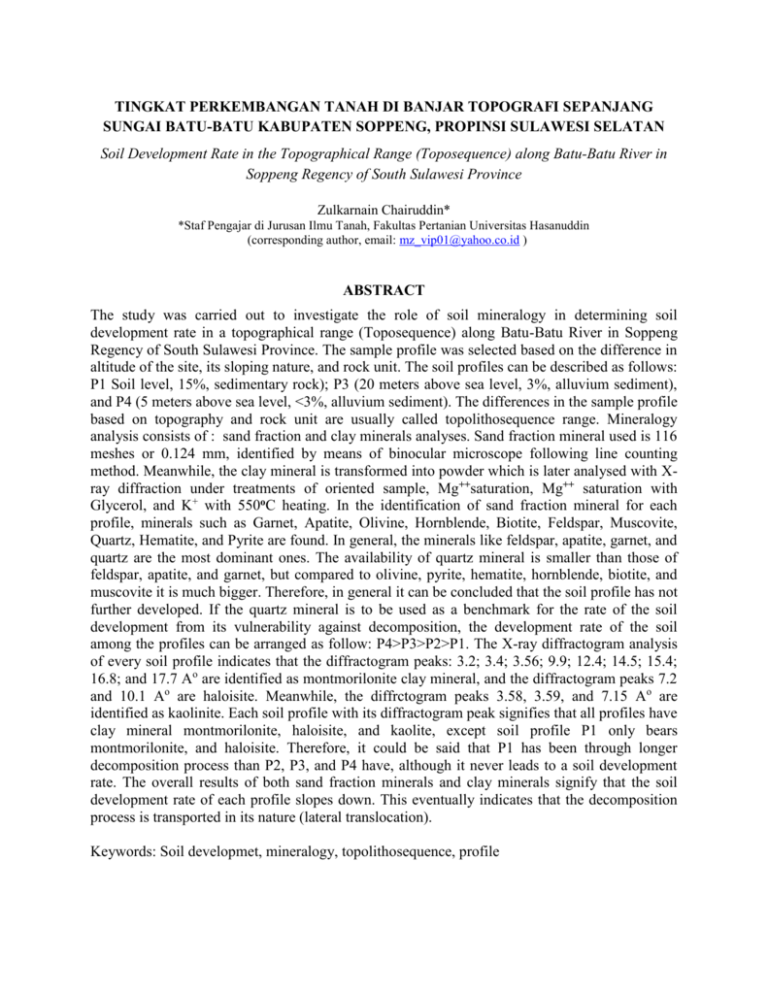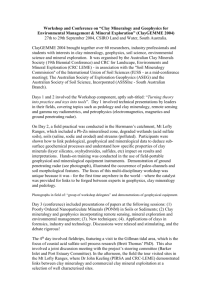View/Open
advertisement

TINGKAT PERKEMBANGAN TANAH DI BANJAR TOPOGRAFI SEPANJANG SUNGAI BATU-BATU KABUPATEN SOPPENG, PROPINSI SULAWESI SELATAN Soil Development Rate in the Topographical Range (Toposequence) along Batu-Batu River in Soppeng Regency of South Sulawesi Province Zulkarnain Chairuddin* *Staf Pengajar di Jurusan Ilmu Tanah, Fakultas Pertanian Universitas Hasanuddin (corresponding author, email: mz_vip01@yahoo.co.id ) ABSTRACT The study was carried out to investigate the role of soil mineralogy in determining soil development rate in a topographical range (Toposequence) along Batu-Batu River in Soppeng Regency of South Sulawesi Province. The sample profile was selected based on the difference in altitude of the site, its sloping nature, and rock unit. The soil profiles can be described as follows: P1 Soil level, 15%, sedimentary rock); P3 (20 meters above sea level, 3%, alluvium sediment), and P4 (5 meters above sea level, <3%, alluvium sediment). The differences in the sample profile based on topography and rock unit are usually called topolithosequence range. Mineralogy analysis consists of : sand fraction and clay minerals analyses. Sand fraction mineral used is 116 meshes or 0.124 mm, identified by means of binocular microscope following line counting method. Meanwhile, the clay mineral is transformed into powder which is later analysed with Xray diffraction under treatments of oriented sample, Mg++saturation, Mg++ saturation with Glycerol, and K+ with 550oC heating. In the identification of sand fraction mineral for each profile, minerals such as Garnet, Apatite, Olivine, Hornblende, Biotite, Feldspar, Muscovite, Quartz, Hematite, and Pyrite are found. In general, the minerals like feldspar, apatite, garnet, and quartz are the most dominant ones. The availability of quartz mineral is smaller than those of feldspar, apatite, and garnet, but compared to olivine, pyrite, hematite, hornblende, biotite, and muscovite it is much bigger. Therefore, in general it can be concluded that the soil profile has not further developed. If the quartz mineral is to be used as a benchmark for the rate of the soil development from its vulnerability against decomposition, the development rate of the soil among the profiles can be arranged as follow: P4>P3>P2>P1. The X-ray diffractogram analysis of every soil profile indicates that the diffractogram peaks: 3.2; 3.4; 3.56; 9.9; 12.4; 14.5; 15.4; 16.8; and 17.7 Ao are identified as montmorilonite clay mineral, and the diffractogram peaks 7.2 and 10.1 Ao are haloisite. Meanwhile, the diffrctogram peaks 3.58, 3.59, and 7.15 Ao are identified as kaolinite. Each soil profile with its diffractogram peak signifies that all profiles have clay mineral montmorilonite, haloisite, and kaolite, except soil profile P1 only bears montmorilonite, and haloisite. Therefore, it could be said that P1 has been through longer decomposition process than P2, P3, and P4 have, although it never leads to a soil development rate. The overall results of both sand fraction minerals and clay minerals signify that the soil development rate of each profile slopes down. This eventually indicates that the decomposition process is transported in its nature (lateral translocation). Keywords: Soil developmet, mineralogy, topolithosequence, profile






